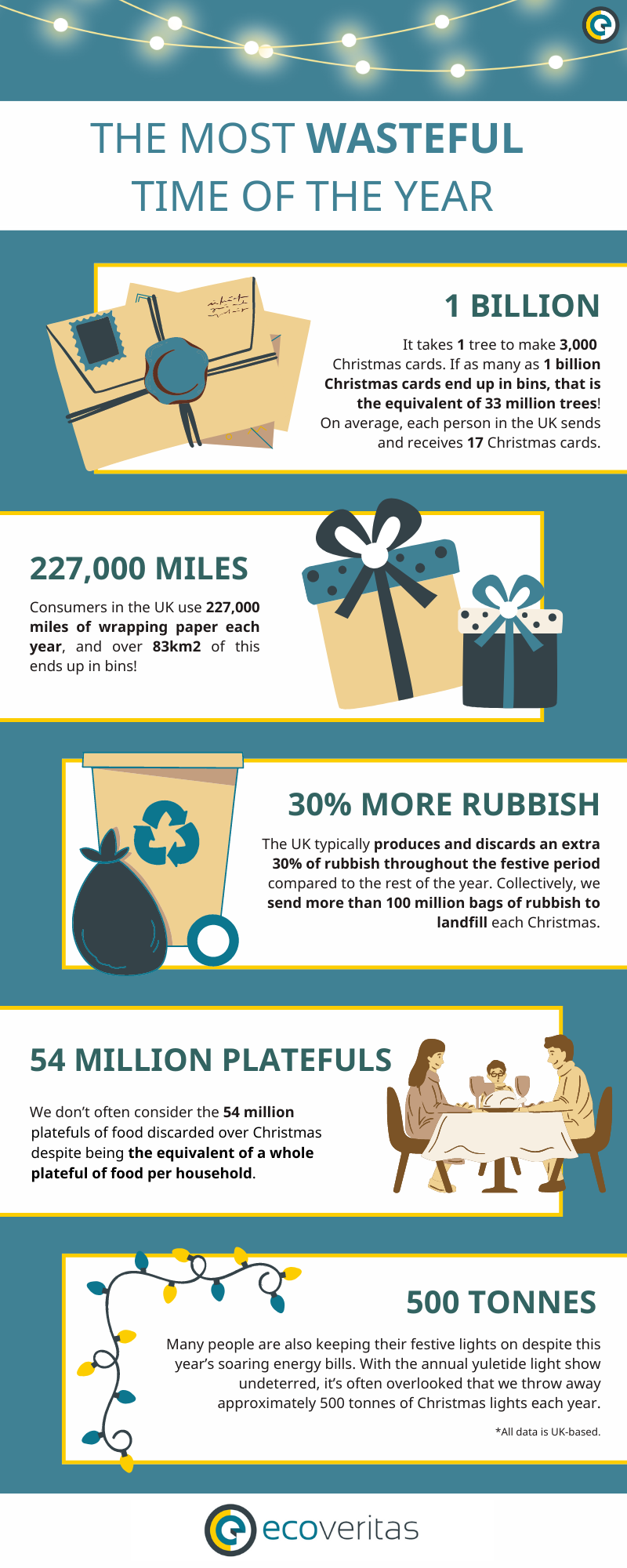The UK produces and discards an extra 30% of rubbish throughout the festive period. That’s 100 million bags of rubbish to landfill each Christmas
We throw away approximately 500 tonnes of Christmas lights each year
54 million platefuls of food are discarded over Christmas
We snap up 227,000 miles of wrapping paper each year, and over 83km2 of this ends up in bins
Ecoveritas is reminding us that as party season kicks in, so will the effects of our excessive waste.
Christmas is a time for giving, receiving, and chucking packaging in the recycling bin. A time when we feel guilty about wheelie bins full of wrapping paper and drawers of unwanted gifts.
Never mind the famous, bright red Coca-Cola truck; the Christmas juggernaut is about to thunder into town, bringing December in all its excess with it.
From groaning fridges to hands sore from carrying shopping bags, the Christmas boost to how much we consume is alive and well. But some families, enthused by environmental campaigners appalled at the tide of plastic junk generated by the season, are ditching frenzied shopping for more sustainable celebrations.
Most of the damage has already been done. Over the past two weeks, you will have determined the shape and size of your ecological festive footprint, defined by how far you have travelled (and how), and indeed how far your Christmas dinner has travelled - through to the amount of plastic packaging surrounding the lovely bath set you just bought.
But as you ferry the emergency chairs back to their rightful homes, reflecting on the unfeasibly large mounds of festive trash left over, why not make it your mission to have a greener Christmas next year?
Deck the halls with boughs of... anything eco-friendly!
Could we soon turn our backs on Christmas consumerism? We can make a difference by cutting back on prominent areas of excess, like unwanted gifts, plastic trees and decorations, and unrecyclable wrapping paper.
When we do finally stop shopping, we sit down to eat. On Christmas Day, the average Briton will consume 6,000 calories: the equivalent of 24 baked potatoes. A Christmas dinner main course is only 1,000 calories, but all the extras, puddings and booze tip the scale.
We don’t often consider the 54 million platefuls of food discarded over Christmas despite being the equivalent of a whole plateful of food per household.
Many people are also keeping their festive lights on despite this year’s soaring energy bills. With the annual yuletide light show undeterred, it’s often overlooked that we throw away approximately 500 tonnes of Christmas lights each year.
Traditionally, crackers have been one of the most environmentally-unfriendly festive purchases, with lots of single-use plastic destined for landfills and a pile of paper and packaging to deal with.
Thankfully, many UK retailers have stopped selling crackers containing plastic toys, ditched the glitter that can make recycling a challenge, and in some cases, even switched to using recycled paper.
‘Tis the season to be jolly good to the planet
Christmas poses many challenges, but none as insurmountable as how to stop its shift towards becoming a predominantly commercial enterprise focused on gift-giving, social engagements, and endless shopping.
The UK typically produces and discards an extra 30% of rubbish throughout the festive period compared to the rest of the year. Biffa – a waste management company – also suggests that collectively people send more than 100 million bags of rubbish to landfill each Christmas.
Consumers in the UK use 227,000 miles of wrapping paper each year, and over 83km2 of this ends up in bins. The Department for Environment, Food and Rural Affairs estimate that the paper used each year is enough to wrap the island of Guernsey.
Even worse, most of this paper cannot be recycled as it contains plastic (glitter or laminates).
But the good news is that there is plenty of choice when it comes to eco-friendly options. Many retailers have made their wrapping paper recyclable; newspaper and brown paper are easy to recycle, and natural twine is much better than non-recyclable sticky tape.
Even Christmas cards have fallen under the environmental spotlight. It takes one tree to make 3,000 Christmas cards. If as many as 1 billion Christmas Cards end up in bins, that is the equivalent of 33 million trees!
Most Christmas cards are paper-based and can be recycled, along with their envelopes, either in your household collections or at local recycling points. But you can play your part: embellishments such as ribbons or glitter cannot be recycled, so they should be removed first by simply tearing off that section.
Arguably the greenest option is to go paperless and send e-cards to your loved ones or consider whether you can get more use out of your cards by upcycling them into decorations or gift tags for next Christmas.
Combined, UK households throw away three-and-a-half black bags full of festive packaging each year. This additional waste equates to somewhere in the region of 3 million tonnes.
Something must be done. Our extravagance is off the scale, and alternatives are not easy, but there are some useful ideas for those seeking them. Why not dream of a greener future?
Next Christmas doesn’t have to cost the earth.
www.ecoveritas.com


 Deutsch (Germany)
Deutsch (Germany)  Polski (PL)
Polski (PL) 







